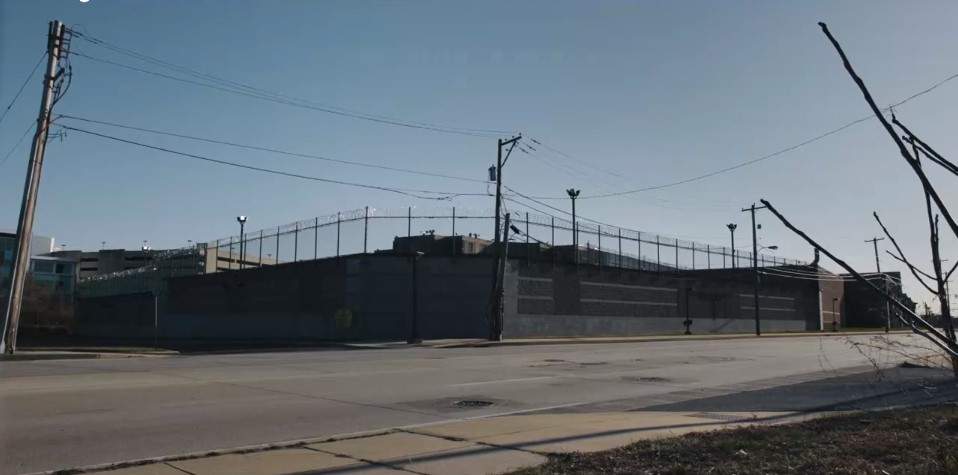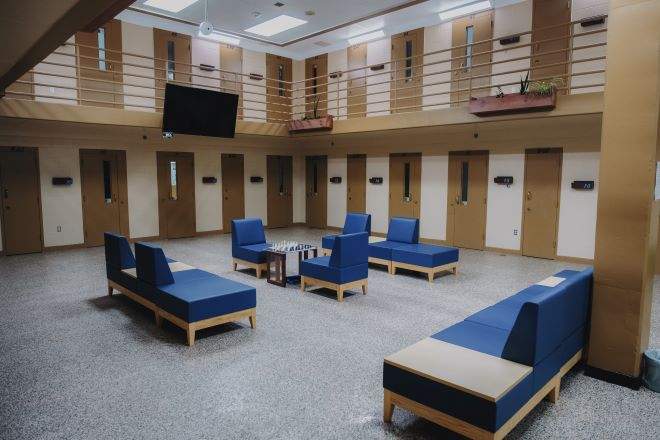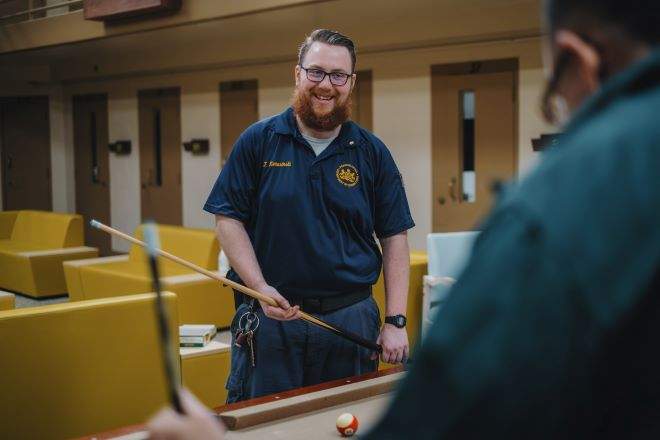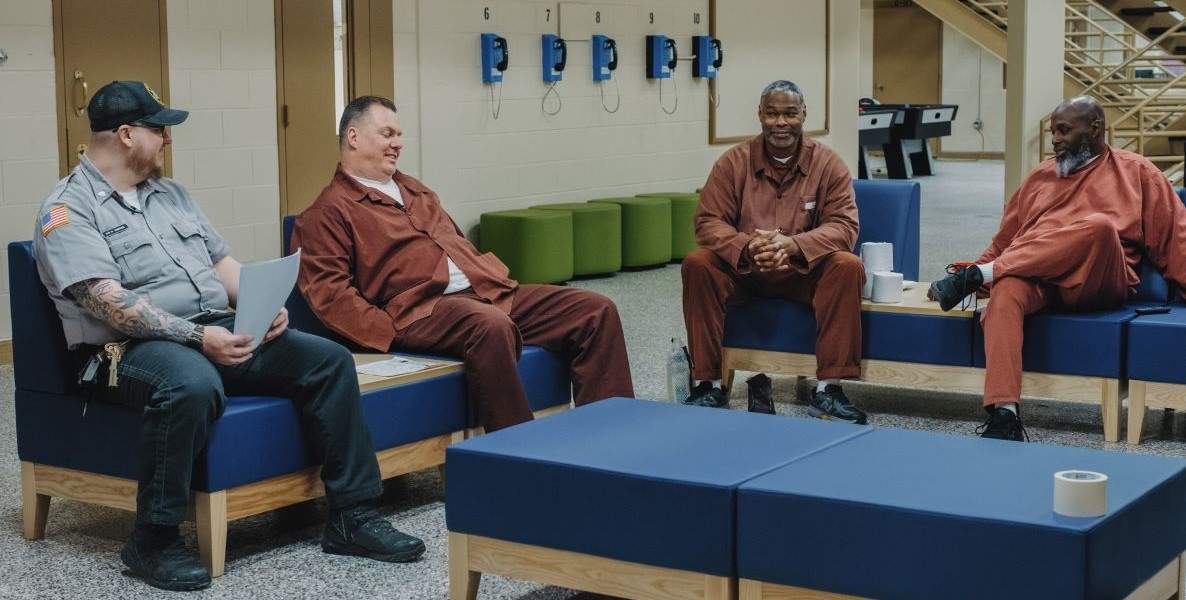The mural is the first thing you notice as you walk into SCI Chester unit CA. On the wall outside the double doors, cheerful words encircle a large, unconventional but recognizable Earth: “Little Scandinavia” and “Norway Sweden Chester … Neighbors.”
Every other unit is painted in standard-state-institution cool white, blue, and gray. This one is painted in warm brown, orange, and creams. In the common area is a large fish tank and potted plants. Off to one side is a stocked kitchen. This unit houses up to 64 individuals, with a higher staff ratio, a more comfortable, community-oriented environment, and access to regular-life activities, like cooking your own meals.
The unit’s unusual design has a purpose: CA is home to a long-term project determining how the Scandinavian approach to incarceration impacts inmates and correctional officers over the short- and long-term.
“Little Scandinavia” is a living lab for the Scandinavian Prison Project, a joint, multi-year effort between the Pennsylvania Department of Corrections, Kriminalvården (the Swedish Prison and Probation Service) and Kriminalomsorgen (The Norwegian Correctional Service), supported by a research team led by Drexel University and the University at Oslo in Norway. Jordan M. Hyatt, Associate Professor of Criminology and Justice Studies at Drexel, and Synøve Nygaard Andersen, a postdoctoral fellow in Sociology at the University of Oslo, direct the study, which is being documented by Swedish Public Television (SVT).
The revolving door of American prisons
Nearly 2 million Americans are currently incarcerated, of which 514,000 are housed in local jails awaiting trial or serving shorter sentences; 209,000 are in federal prison; and over 1 million are in state prisons. Historically, the principles behind criminal incarceration have been deterrence, punishment, incapacitation, and rehabilitation. But with such a large population serving so much time, the U.S. system largely fails at rehabilitation.
“The goal is not to be Sweden, the goal is to be better in Pennsylvania” — Jordan Hyatt, Scandinavian Prison Project researcher
Worse: Not only does incarceration in the U.S. fail to deter criminal activity — it seems to increase the likelihood of reoffending. Recidivism rates in the U.S. are some of the highest in the world. Studies show that nationwide, 62 percent of the previously incarcerated are rearrested within three years, and 71 percent are rearrested within five years.
Recidivism is an incomplete metric of incarceration’s effectiveness; still, it’s surprising anyone at all comes out of prison rehabilitated. Violence, drug abuse, sex abuse, and hate groups are traumatic fixtures of prison life. State prisons, which incarcerate most Americans, are notoriously deadly. Since 2001, the Bureau of Justice Statistics has documented a 1 percent rise in the state prison population — and a 44 percent increase in deaths.
Scandinavian countries are different than the United States in several fundamental ways. Norway, Sweden, Denmark, and Finland are much smaller than the U.S. in geography and population, and have strong social support systems. Crime rates are much lower. Gun violence is relatively rare, to the point that the recent surge in Swedish gun homicides — 61 in 2022 — has prompted angry calls from the public for accountability. In Norway, prison sentences are capped at 21 years. Life and decades-long sentences are common in the U.S., even for nonviolent offenders.
In large part, the world accepts the United Nations’ Standard Minimum Rules for the Treatment of Prisoners as the foundational rules around incarceration. Many facilities in the U.S. fail to meet these standards by providing substandard medical care, for example, or subjecting inmates to prolonged solitary confinement — including for children.
At Chester, the researchers are considering whether the Scandinavian system might hold keys to reforming U.S. prison conditions and outcomes. “We need to take seriously the nature and the impact of the prison environment,” Andersen says. “So many spend huge parts of their lives in prison, right? The incarcerated population, but also the people who work there. It’s time to really take seriously how to make that environment at least not damaging to anyone’s health; to make it as safe as possible for people to go in and out of these facilities. Maybe even consider challenging the notion that prison has to be a horrible place for it to feel like punishment.”

Little Scandinavia’s origins
When Hyatt, a Philadelphia native, was living and teaching in Sweden, he became interested in how the welfare state interacts with people’s lives. Later, while studying law at Villanova, he became interested in criminal justice. He earned his Ph.D. in philosophy and criminology at Penn.
Andersen earned her Ph.D. at the University of Oslo and met Hyatt at a 2015 conference while researching at the University of California, Irvine. “It’s hard not to compare when you travel,” she says. “You learn so much about the place that you come from yourself, whether it’s work or just life in general. For me, it was very interesting to be in the U.S. and to talk to people who thought very differently about prisons and what a prison isn’t supposed to be.”
Hyatt and Andersen acted on their shared interest in criminal justice — specifically, prison systems. Together, they launched several research and teaching programs involving students traveling to Scandinavian countries comparing prisons to the U.S., and this was the genesis of the Scandinavian Prison Project.
In 2013, former PA Department of Corrections (DOC) Secretary John Wetzel traveled to Europe for a first-hand look at prisons in Germany and the Netherlands. In Germany, inmates sleep in full-size beds, wear street clothes, and cook their own meals. Solitary confinement is rare and never exceeds eight hours. German inmates receive real wages, establishing savings for release. German measures of recidivism, as a comparison, are about 35 percent after three years — less than half of those in the U.S.
“It’s time to really take seriously how to make that environment at least not damaging to anyone’s health; to make it as safe as possible for people to go in and out of these facilities.” — Synøve Nygaard Andersen, Scandinavian Prison Project researcher
Upon returning, Wetzel referred to the trip as “a transformative experience.” He told 90.5FM, Pittsburgh’s NPR affiliate, “The culture and environment they were able to create inside their prisons were something that I never had seen or experienced before. And at the time, I had well over 25 years of experience and toured literally hundreds of facilities here in America.”
By 2017, Andersen and Hyatt had developed the idea for a research project that would bring Scandinavian incarceration principles to a U.S. facility. Wetzel signed on. Grants from Arnold Ventures and the Nordic Research Council for Criminology would fund the project, among others.
Documenting the project are Swedish Public Television (SVT) producers John Stark and Tomas Lindh, whose acclaimed 2017 prison documentary Breaking the Cycle was on Netflix and shown in Drexel’s criminal justice classes. The filmmakers, whom Hyatt and Andersen call “our third partner,” worked out an agreement with the DOC and began following the project at its very start.
“As a strictly noncommercial public service, it’s important for us not to say that this is good; this is bad, but rather provide insight, information,” Stark says. “What happens behind those headlines of being tough on crime?”
Lindh says, “From the get-go, we were very clear that we can film this, but it needs to be true to reality.” He also wanted to reveal another side of incarceration: its effects on Corrections Officers (COs). “What happens to a person who is working in these environments that are loud, hostile, and stressful — the effects on their private life, their families, their health? All those aspects of the world of incarceration have so far been rather invisible.”
The ideal laboratory
For the DOC, SCI Chester was the natural choice to host the research project. A medium-security facility that provides alcohol and substance abuse treatment, SCI Chester is also a “last stop” for inmates on the way to release. The facility is also fairly stable — 17 of its staff have been there since it opened in 1998.
Everyone in the facility, which houses around 1,100 inmates, is on the same schedule. Five of the 14 housing units are based around therapeutic communities, which are a participative, group-based treatment approach to long-term mental illness, personality disorders, and addiction for residential settings. One unit has all-Spanish programming.
SCI Chester inmates have access to a barber shop, music and art spaces, a computer lab, a library, and classrooms where nearly every educational institution in the region offers college-level courses. HVAC and carpentry vocational programs teach inmates valuable skills (the counter in the entry lobby was manufactured in-house). Honor blocks, for inmates who meet certain criteria, include workout areas, washers and dryers, and ice machines. Some units have a pet program for dogs and cats. Older residents get their own lounge for time away from the activity on the block and in the day rooms.
Making prison an unhealthy, dangerous, and painful experience does not further justice.
In 2019, prison staff, members of the Department of Corrections, and the film crew traveled to Norway, Sweden, and Denmark. In Norway, they toured the Correctional University Training Institute (KRUS), juvenile detention facilities, halfway houses, and several different prisons. While the COs stayed in Norway for mentorships in three prisons near Oslo, DOC leadership went on to Sweden and Denmark to learn about prisons there.
Upon their return, Unit CA was converted to meet the population and supervision requirements of the project and introduce new elements: single cells, a communal kitchen, “Nordic-like” furniture, with clean lines, natural materials, and a functional purpose, potted plants and an aquarium that Inmates and staff care for. In March 2020, six men serving life sentences moved in to serve as mentors to younger inmates. Then, Covid. The film crew, now on an unscheduled one-and-a-half-year break, supplied the unit with a diary cam for inmates to film themselves during lockdown.

After Covid, a large group from the DOC, including acting secretary George Little and SCI Chester staff, returned to Sweden for a 10-day refresher. Correctional Officer Ellis was on that 2022 trip. “We woke up in the morning, and went to work, just like we do here, and had a mentor, just to see how they do things,” Ellis says. “The idea is that residents that are there will be there. Then they’re leaving to go home. So who do you want to come out of prison: a better person?”
Little Scandinavia
Like all visitors to Little Scandinavia, when I went to see it in May, the superintendent’s assistant insisted I toured the entire facility. I arrived at the start of a facility-wide refresh. The walls had been whitewashed. Next, they’ll update color and furniture.
Regular housing units at SCI Chester hold up to 128 men in shared cells. Little Scandinavia is designed for a max population of 64. When I visited, 47 men lived on the block. Because this is a functioning scientific study, any SCI inmate (except someone with a staff assault or other security issues) is eligible for the lottery to reside here. CA residents include men serving life, long-term inmates, and men readying for release.
In the rest of the facility, the staff-to-inmate ratio is 1:128. In CA, it’s 1:8. Little Scandinavia officers are specially-trained and permitted to communicate with and provide personal counsel and support to inmates. The common area is designed to encourage community. The grocery program allows them to work with staff to purchase fresh foods online that inmates can cook. CA residents participate in work, treatment, and school, just like in the rest of the facility.
“Who do you want to come out of prison: a better person?” — SCI Chester Corrections Officer Ellis
The study includes a substantial variety of data collection. Inmates and staff assigned to the unit complete a survey before arriving and at regular intervals afterward. A team of qualitative researchers is conducting hundreds of hours of interviews and collecting administrative data on infractions like contraband or violence. Researchers also follow inmates post-incarceration. The study also acts as a feasibility pilot for the DOC for other facilities.
Joe, an older White man with a neatly trimmed white beard, was one of the six mentors chosen just before Covid hit. [SCI Chester rules withhold identifying details, including last names and crimes for which they were convicted.] “We had a lot of time to reflect on things you need to do, and then once we got out of Covid, and we started getting our program up and running, that’s when it really … it’s been amazing,” he says. “There’s more of a sense of community compared to other units. The guys here seem to look out for each other more, help each other more.”
Joe has served time long enough that he has what he calls “a PhD in prison.” He sees the environment of Little Scandinavia changing individuals serving time here. “Guys are getting serious about getting out,” he says. “Any resources you need, you go to the contact officers, to get help, more than on the regular block. I’ve seen a lot of guys go home, and they’ve been doing pretty well.”
Erik is a tall, middle-aged Black man who arrived in Little Scandinavia in year 19 of his 20 years spent in various prisons. “What you and I are doing right now, just sitting here talking? It’s unheard of,” he says. Erik describes the lack of trust and the isolation he experienced in prison. In this unit, he can express his emotions, and is free to work through trauma he’s experienced with support from other inmates and the officers. Here, he says, “We’re less stressed.”
What could we learn from this project?
The essence of the Scandinavian approach to justice behind Little Scandinavia: Not everyone in prison will rejoin the community, but those who do shouldn’t be bringing trauma with them. That is harmful, not just for them, but for their families and communities. For those who will remain incarcerated for life, they’re sharing the same space with officers and other inmates. Making prison an unhealthy, dangerous, and painful experience does not further justice — and it, too, is harmful for their community.
“The data that we have collected so far suggest that both the residents and the staff perceive this unit to be different from other units at Chester,” says Andersen. “And one thing that stands out is the interpersonal relationships, both within the group of men on the unit — the sense of community — but also between the staff and the residents. They have more time now to actually talk about things.”
The point of the Scandinavian Prison Project is not to make America more like Sweden or Norway. That’s beyond the scope of criminal justice reform, or even social services and public safety reform.

“The benchmark really isn’t, How Scandinavian are these outcomes in Pennsylvania, but rather, How much better are we doing in Pennsylvania than we were going to do otherwise?” explains Hyatt. “The goal is not to be Sweden; the goal is to be better in Pennsylvania. And we look at that both in terms of the prison climate, what’s happening to the people who live and work in prison, and then how that impacts communities.”
The researchers stress that even if their study continues to show improved outcomes for both inmates and officers, rethinking the prison model is not — cannot be — the only answer to fixing criminal justice.
“I think one thing that’s very important to remember is that a prison is the last outpost in society, and so much has gone wrong before that,” says Stark. “So, if the data shows that this project works, and it could be expanded, great, then it can benefit society and, you know, make taxpayers’ money work in a better, more efficient, and beneficial way. But still, this is just one piece of the puzzle, you know? What else could be done before that point?”
![]() MORE CRIMINAL JUSTICE REFORM FROM THE CITIZEN
MORE CRIMINAL JUSTICE REFORM FROM THE CITIZEN
Inmates and correctional officers discuss their experiences in the Unit CA common area. Photo by Sweden Public Television (SVT) producers John Stark and Tomas Lindh



